len3.8 said:think he (Gerry) said his car was slipping or had problems with the straps, so we had somewhat of an incomplete reading.
When the plot was first posted a while back, I thought the incomplete plot was the cause too. . But I looked at it closer tonight and it appears that the hp curve flattens out well before the graph broke up due to slippage. Which brought the question to my head of, "How'dhedodat without spray?" Even if nitrous was used (which is not what I am saying), that plot is still quite impressive.




